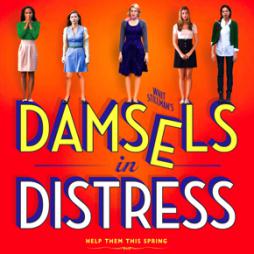 Damsels in Distress/2011/Sony Pictures Classics/99 min.
Damsels in Distress/2011/Sony Pictures Classics/99 min.
“Damsels in Distress” marks the return of writer/director/producer Whit Stillman (“Metropolitan” 1990, “Barcelona” 1994, “Last Days of Disco” 1998) after a 14-year hiatus. Stillman’s milieu is upper-middle-class young people – educated and privileged, often naïve and neurotic – and the complications of their friendships and romances.
He brings his distinctive, dryly funny stamp to the sagas of preppy angst, in this case a group of girls at an East Coast college who attempt to live well amid their smelly male coeds. One of their pet projects is cheering up depressed kids via coffee and doughnuts, divinely scented soap and the shuffle steps of tap-dance routines.
Leader Violet (Greta Gerwig) is sweet, smart and well intentioned, if a bit self-deluded. Violet’s dating philosophy is to bypass the cool men and instead “take a guy who hasn’t realized his full potential, or doesn’t have much, then help him realize it or find more.” She also yearns to make her mark on the world by starting a new dance craze.
Her pals are the chaste, regal Rose (Megalyn Echikunwoke) and the dainty, Barbie-like Heather (Carrie MacLemore). New to the group is transfer student Lily (Analeigh Tipton), who is, gasp, unfazed by an unwelcome whiff of body odor.
Cute boys on campus include solicitous Jimbo (Jermaine Crawford), student newspaper editor Rick (Zach Woods), sexy French grad student Xavier (Hugo Becker), doltish frat brothers Frank (Ryan Metcalf) and Thor (Billy Magnussen), and businessman wannabe Charlie (Adam Brody).
When Violet’s heart is broken – she insists she is not depressed but merely in a tailspin – her idealistic ambitions take a backseat to her emotional recuperation.
With smart material and an appealing cast, “Damsels” is entertaining. Stillman’s low-key, reserved comedic style gently reveals his characters’ foibles and affectations. But, though the groundwork has been laid with likeable female characters, romantic entanglements and unraveling identities, the story ultimately feels a bit half-baked. Also, some of the character’s quirks seem strangely tacked on rather than uniquely charming. For example, Lily, randomly, has never seen an artichoke.
Lily is set up as the rebel of the girls’ group and, though she does gently challenge Violet early on, that dramatic tension fizzles out fairly quickly. What propels the story after that, for the most part, is wondering who will end up with whom. The clever and whimsical dialogue engages us but rarely do we sense that there is much at stake during these quaintly amusing discussions.
And beneath their grimy exteriors, the men tend to be disappointingly bland, sometimes downright moronic. Zach Wood as the editor of the paper is the most promising of the lot but unfortunately, after a promising introduction, he’s relegated to the sidelines.
Still, “Damsels” does offer witty humor and endearing performances. And a bonus: if your inner-grammarian has ever fretted about properly using the plural of the word doofus, “Damsels” provides helpful counsel.
“Damsels in Distress” opens today in New York and LA.











From FNB readers